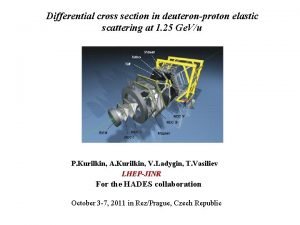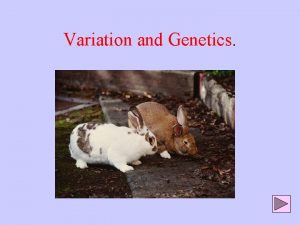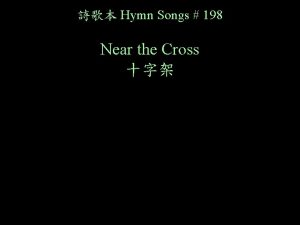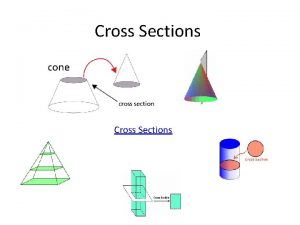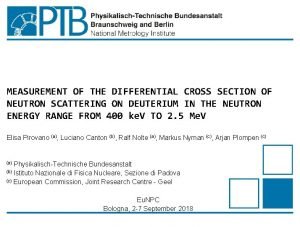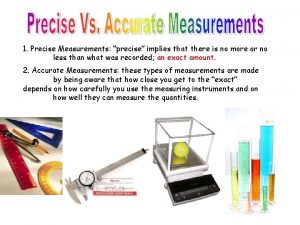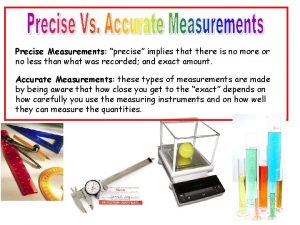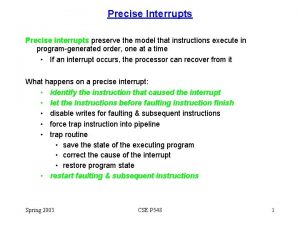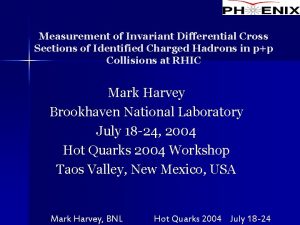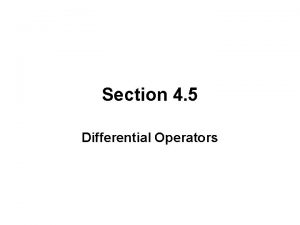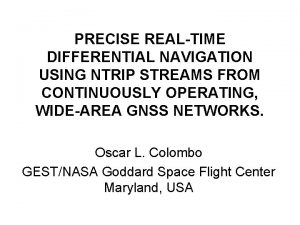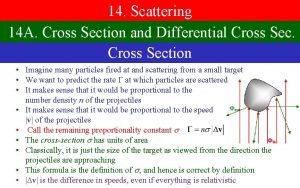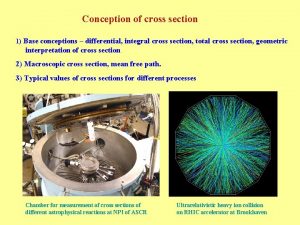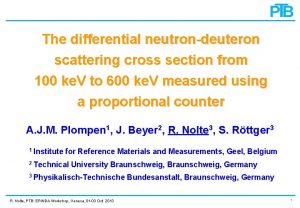Precise Measurement of the Differential Cross Section for


























- Slides: 26

Precise Measurement of the Differential Cross Section for and Scattering (Final Result) Martin Tzanov University of Pittsburgh Introduction • Nu. Te. V experiment • Differential cross section and structure functions Method • Differential cross section extraction • F 2 and x. F 3 measurement Results Conclusions Martin Tzanov DIS 2005 April, 2005

Nu. Te. V Collaboration T. Adams 4, A. Alton 4, S. Avvakumov 8, L. de Barbaro 5, P. de Barbaro 8, R. H. Bernstein 3, A. Bodek 8, T. Bolton 4, S. Boyd 7, J. Brau 6, D. Buchholz 5, H. Budd 8, L. Bugel 3, J. Conrad 1, R. B. Drucker 6, B. T. Fleming 1, J. Formaggio 1, R. Frey 6, J. Goldman 4, M. Goncharov 4, D. A. Harris 8, J. H. Kim 1, S. Koutsoliotas 1, R. A. Johnson 2, M. J. Lamm 3, W. Marsh 3, D. Mason 6, J. Mc. Donald 7, K. S. Mc. Farland 8, C. Mc. Nulty 1, D. Naples 7, P. Nienaber 3, V. Radescu 7, A. Romosan 1, W. K. Sakumoto 8, H. Schellman 5, M. H. Shaevitz 1, P. Spentzouris 1, E. G. Stern 1, N. Suwonjandee 2, N. Tobien 3, M. Tzanov 7, A. Vaitaitis 1, M. Vakili 2, V. Wu 2, U. K. Yang 8, J. Yu 3, G. P. Zeller 5 1 Columbia 2 University 3 Fermi State University, Manhattan, KS Northwestern University, Evanston, IL 6 Martin Tzanov of Cincinnati, OH Nat'l Accelerator Lab, Batavia, IL 4 Kansas 5 University, New York, NY University of Oregon, Eugene, OR 7 University of Pittsburgh, PA 8 University of Rochester, NY DIS 2005 April, 2005

Nu. Te. V Detector µ W+ q Muon Spectrometer: • Three toroidal iron magnets with five sets of drift chambers Target Calorimeter: • Steel-Scintillator Sandwich (10 cm) -resolution • Tracking chambers for muon track and vertex MCS dominated • Always focusing for leading muon New feature: Continuous Calibration Beam Hadron energy scale Martin Tzanov q’ Muon energy scale DIS 2005 April, 2005

Neutrino Beamline • Nu. Te. V accumulated over 3 million neutrino/ antineutrino events in 1996 -1997 20 ≤ E ≤ 400 Ge. V • Wrong-sign /K are dumped Nu. Te. V selects neutrinos or antineutrinos • High purity neutrino or antineutrino beam - high y CC sample - tag leading muon Martin Tzanov DIS 2005 April, 2005

Neutrino-Nucleon Scattering Squared 4 -momentum transferred to hadronic system Fraction of momentum carried by the struck quark Inelasticity Differential cross section in terms of structure functions: Structure Functions in terms of parton distributions -scattering only Martin Tzanov DIS 2005 April, 2005

Extraction of the Differential Cross Section in terms of number of events and the flux: Monte Carlo event generator is used for acceptance: DATA • Cross section model: CROSS SECTION Samples FLUX Sample Toroid µ Events selection criteria: • Toroid muon : Good muon track, containment, Eµ>15 Ge. V, EHAD>10 Ge. V, 30<Eν<360 Ge. V Q 2>1 Ge. V 2/c 2 • Target muon: 4<Eµ<12 Ge. V Target µ -QCD inspired fit using Buras – Gaemers 1 param. -Q 2 evolution from GRV for Q 2<1. 35 Ge. V/c. Includes fit for x>0. 4 to SLAC, NMC and BCDMS to account for FLUX CROSS SECTION non-perturbative behavior at low Q 2 and high x • Detector model: MONTE CARLO Cross Section Model + Detector Response Model - Eµ and EHAD resolution functions are parameterized using Test Beam (TB) muons and hadrons - θμ is parameterized as a function of EHAD and event Data sample (EHAD<20 Ge. V) is used to extract the FLUX Martin Tzanov position using GEANT hit level Monte Carlo 1(A. Buras, K. Gaemers, Nucl. Phys. B 132, 249 (1978)) DIS 2005 April, 2005

Systematic Uncertainties There are 23 systematic uncertainties which are considered: The 2 including all systematic uncertainties is given by • Eµ and EHAD energy scales affect both the flux and the diff. cross section extraction • mc and flux uncertainty are important for the relative flux extraction • neutrino world average cross section has 2. 1% uncertainty – used to normalize the flux. (included as overall normalization) M - point to point covariance matrix ij - 22 x 22 correlation matrix of all uncertainties σαi - the size of systematic uncertainty i at data point α Each derivative is calculated by varying the corresponding systematic Si by a small εi using: • the uncertainty in the Eµ and EHAD energy smearing models. • 16 model fit parameters. Martin Tzanov • statistical uncertainty is added in quadrature to the diagonal element of the matrix DIS 2005 April, 2005

Monte Carlo Modeling of Data Anti- Martin Tzanov DIS 2005 April, 2005

Nu. Te. V CC Cross Section CDHSW CCFR Nu. Te. V Eµ scale EHAD scale 2% 1% 0. 7% 2. 5% 1% 0. 43% E range (Ge. V) 20 -200 30 -360 • All systematics are included. • Nu. Te. V has comparable statistics to other ν-Fe experiments. • Reduction in the largest systematic uncertainties : - Eµ and EHAD scales Other ν-Fe data shown on the plot: CDHSW(Z. Phys. C 49 187, 1991) U. K. Yang CCFR Ph. D. Thesis Martin Tzanov DIS 2005 April, 2005

Nu. Te. V’s CC Cross Section Martin Tzanov DIS 2005 April, 2005

Nu. Te. V vs CCFR • Nu. Te. V agrees with CCFR for x<0. 4. • Increasingly higher than CCFR at x> 0. 4 - x=0. 45 - 4% - x=0. 55 - 10% - x=0. 65 - 20% Investigating the discrepancy with CCFR: • similar detectors and techniques • Nu. Te. V has improved hadron energy calibration - 1 -2% effect at x=0. 65 • precise calibration of the muon spectrometer - the difference in the CCFR and Nu. Te. V magnetic field models is an effective 0. 8% shift in the muon energy scale - 5% at the x=0. 65 • improved muon energy smearing model - 2% at x=0. 65 • different model fit parameters - 3% effect at x=0. 65 • Other differences are: - Nu. Te. V had separate neutrino and antineutrino beams All together account for 11% of the 20% - Nu. Te. V - always focusing for the “right-sign” muon difference at x=0. 65. Systematic errors are 6 -7% at - CCFR – simultaneous neutrino and antineutrino runs - CCFR toroid polarity was half of the time focusing for x=0. 65. The two results will be in 1. 5 agreement. µ+ and half of the time µMartin Tzanov DIS 2005 April, 2005

F 2 and x. F 3 Measurement F 2 x. F 3 • Perform 1 -parameter fit for F 2 • Perform 1 -parameter fit for x. F 3 • 1 TR-VFS x. F 3 model • 2 R model w • F 2 is very small and is neglected 1(R. S. Thorne and R. G. Roberts, Phys. Lett. B 421, 303 (1998)). 2(L. W. Whitlow et. al. Phys. Lett. B 250, 193 (1990)). • Radiative corrections applied (D. Y. Bardin and Dokuchaeva, JINR-E 2 -86 -260 (1986)) • Isoscalar correction applied • Bin centering correction for Q 2 Martin Tzanov DIS 2005 April, 2005

F 2 Measurement • Isoscalar ν-Fe F 2 • Nu. Te. V F 2 is compared with CCFR and CDHSW results - the line is a fit to Nu. Te. V data • All systematic uncertainties are included • All data sets agree for x<0. 4. • At x>0. 4 Nu. Te. V agrees with CDHSW • At x>0. 4 Nu. Te. V is systematically above CCFR Martin Tzanov DIS 2005 April, 2005

x. F 3 Measurement • Isoscalar ν-Fe x. F 3 • Nu. Te. V x. F 3 is compared with CCFR and CDHSW results - the line is a fit to Nu. Te. V data • All systematic uncertainties are included • All data sets agree for x<0. 4. • At x>0. 4 Nu. Te. V agrees with CDHSW • At x>0. 4 Nu. Te. V is systematically above CCFR Martin Tzanov DIS 2005 April, 2005

Comparison with Charge Lepton Data for x>0. 4 • Baseline is Nu. Te. V model fit • data points are • charge lepton data is corrected for: - using CTEQ 4 D - heavy target Q 2 • Nu. Te. V agrees with charge lepton data for x=0. 45. • Nu. Te. V is higher than BCDMS(D 2), different Q 2 dependence - 7% at x=0. 55, 12% at x=0. 65, and 15% at x=0. 75 • Nu. Te. V is higher than SLAC(D 2) (bottom 4 plots) - 4% at x=0. 55, 10% at x=0. 65, and 17% at x=0. 75 Perhaps the nuclear correction is smaller for neutrino scattering at high x. Martin Tzanov • the nuclear correction is dominated by SLAC data, which is at lower Q 2 from Nu. Te. V in this region DIS 2005 April, 2005

Comparison with Theory for F 2 • Baseline is TRVFS(MRST 2001 E) • Nu. Te. V and CCFR F 2 are compared to TRVFS(MRST 2001 E) • Theoretical models shown are: - ACOT(CTEQ 6 M) - ACOT(CTEQ 5 HQ 1) - TRVFS (MRST 2001 E) • Theory curves are corrected for: - target mass (H. Georgi and H. D. Politzer, Phys. Rev. D 14, 1829) - nuclear effects – parameterization from charge lepton data, assumed to be the same for neutrino scattering (no Q 2 dependence added) nuclear effects parameterization is dominated by SLAC (lower Q 2 in this region) data at high-x • Nu. Te. V F 2 agrees with theory for medium x. • At low x different Q 2 dependence. • At high x (x>0. 6) Nu. Te. V is systematically higher. Martin Tzanov DIS 2005 April, 2005

Comparison with Theory for x. F 3 • Baseline is TRVFS(MRST 2001 E). • Nu. Te. V and CCFR x. F 3 are compared to TRVFS(MRST 2001 E) • Theoretical models shown are: - ACOT(CTEQ 6 M) - ACOT(CTEQ 5 HQ 1) - TRVFS (MRST 2001 E) • theory curves are corrected for: - target mass (H. Georgi and H. D. Politzer, Phys. Rev. D 14, 1829) - nuclear effects – parameterization from charge lepton data, assumed to be the same for neutrino scattering (no Q 2 dependence added) nuclear effects parameterization is dominated by SLAC (lower Q 2 in this region) data at high-x • Nu. Te. V x. F 3 agrees with theory for medium x. • At low x different Q 2 dependence. • At high x (x>0. 6) Nu. Te. V is systematically higher. Martin Tzanov DIS 2005 April, 2005

Comparison with Theory at Low x • both Nu. Te. V and CCFR agree in level with theory in the shadowing region (except CTEQ 6 M) • the red curve is TRVFS(MRST) using the following model for nuclear correction: NUCLEAR SHADOWING IN NEUTRINO NUCLEUS DEEPLY INELASTIC SCATTERING. By Jianwei Qiu, Ivan Vitev (Iowa State U. ), . Jan 2004. 7 pp. Published in Phys. Lett. B 587: 52 -61, 2004 e-Print Archive: hep-ph/0401062 Martin Tzanov DIS 2005 April, 2005

Nu. Te. VPack • Nu. Te. VPack is a user friendly interface to access Nu. Te. V cross section data • The data represents the Nu. Te. V neutrino and anti-neutrino differential cross section on IRON, along with a full covariance matrix containing all systematic errors. There are no corrections applied to the data. (all radiative effects are in). Data is binned in 12 x-bins, 13 y-bins and 17 E-bins. • A new version of the package allows access to each systematic error separately, as well as combination of systematic errors. (requested by theorists) It will return the covariance (or inverse covariance) matrix for the chosen set of systematic errors. The statistical error is always added in quadrature to the diagonal. Will be available by the end of DIS 2005. We strongly recommend the use of the full covariance matrix. Even in a case of one systematic error there is a bin-to-bin correlation in the data. The Nu. Te. VPack is available for download here: http: //www-nutev. phyast. pitt. edu/results_2005/nutev_sf. html Martin Tzanov DIS 2005 April, 2005

Conclusions • Nu. Te. V has extracted high precision differential cross section. • Nu. Te. V measurement is in an agreement with previous experiments - agrees with CDHSW - agrees with CCFR for x<0. 4 and systematically higher at high x 4% at x=0. 45, 10% at x=0. 55, 20% at x=0. 65 - Nu. Te. V has an improved detector calibration compared to CCFR. - accounts for 11% of the 20% discrepancy at x=0. 65. Both results would be in 1. 5 agreement. • Nu. Te. V agrees with charge lepton data for x<0. 5. - perhaps the nuclear correction at high-x is smaller for neutrino scattering. • Nu. Te. V agrees with theory for medium x. - at low x different Q 2 dependence. Q 2 dependent nuclear shadowing. - differs in level at x>0. 6. • Nu. Te. VPack is available on the web: http: //www-nutev. phyast. pitt. edu/results_2005/nutev_sf. html Future: • Target sample cross section and QCD fits. Martin Tzanov DIS 2005 April, 2005

Flux Extraction Relative flux extraction using “fixed 0 method” • We can rewrite the differential cross section in terms of ν=EHAD integrate over x. Normalizing the relative flux • using world average neutrino cross section for 30 Ge. V < E <200 Ge. V • the neutrino cross section is flat as a function of E within less than 2% • the relative antineutrino cross section agrees with the world average Martin Tzanov DIS 2005 April, 2005

Nuclear Correction Martin Tzanov DIS 2005 April, 2005

Buras-Gaemers Parameterization • Valence quark distributions parameterization: • Sea quark distributions parameterization: • The exponents Ei and ESi and the normalization coefficients AVi and ASi are fitted to Nu. Te. V differential cross section data. • 13 parameters to fit. Fit includes standard QCD evolution, assumes R=Rworld, charm mass, W-mass and sea constraint from dimuon data. Martin Tzanov DIS 2005 April, 2005

Acceptance Correction Martin Tzanov DIS 2005 April, 2005

Radiative Correction Martin Tzanov DIS 2005 April, 2005

Higher Twist • fit to ep, ed data (SLAC, NMC, BCDMS) to account for Target Mass and Higher-Twist effects in parton level cross section model • important at high x and low Q 2 Martin Tzanov DIS 2005 April, 2005
 Differential cross section
Differential cross section Test cross and back cross
Test cross and back cross Test cross and back cross with example
Test cross and back cross with example Type of dominance in genetics
Type of dominance in genetics Difference between monohybrid and dihybrid cross
Difference between monohybrid and dihybrid cross In the cross, in the cross be my glory ever
In the cross, in the cross be my glory ever Balanced occlusion formula
Balanced occlusion formula Iso 22301 utbildning
Iso 22301 utbildning Novell typiska drag
Novell typiska drag Nationell inriktning för artificiell intelligens
Nationell inriktning för artificiell intelligens Returpilarna
Returpilarna Shingelfrisyren
Shingelfrisyren En lathund för arbete med kontinuitetshantering
En lathund för arbete med kontinuitetshantering Personalliggare bygg undantag
Personalliggare bygg undantag Personlig tidbok för yrkesförare
Personlig tidbok för yrkesförare A gastrica
A gastrica Förklara densitet för barn
Förklara densitet för barn Datorkunskap för nybörjare
Datorkunskap för nybörjare Stig kerman
Stig kerman Att skriva en debattartikel
Att skriva en debattartikel För och nackdelar med firo
För och nackdelar med firo Nyckelkompetenser för livslångt lärande
Nyckelkompetenser för livslångt lärande Påbyggnader för flakfordon
Påbyggnader för flakfordon Kraft per area
Kraft per area Svenskt ramverk för digital samverkan
Svenskt ramverk för digital samverkan Jag har gått inunder stjärnor text
Jag har gått inunder stjärnor text Presentera för publik crossboss
Presentera för publik crossboss
